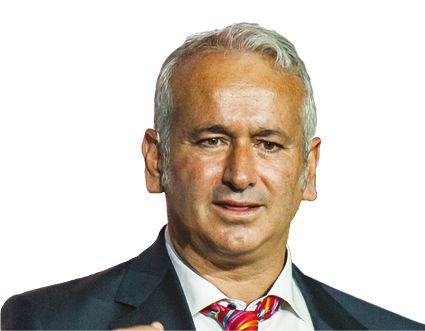How to reinvent portfolio management: a new framework for prioritising projects

The emergence of projects as the economic engine of our times has been quiet, but is incredibly disruptive and powerful. Back in 2017, I coined this phenomenon the ‘project economy’ to highlight this unprecedented transformation with profound organisational and cultural consequences.
Our current methods were designed for a world in which projects were a small fraction of an organisation’s activities. So, current project, programme and portfolio management methods, tools and techniques are ‘old’ and need to be adjusted. Applying those old methods leads to a huge amount of bureaucracy, wasted time and management scepticism about our added value.
To succeed in the project economy, we need to reinvent project management
One way to do this is by reinventing the prioritisation of projects in our portfolios. Prioritisation is vital to individual and organisational success, yet the method of prioritising is little understood and often neglected.
To prioritise projects effectively, leaders must recognise and articulate what really matters most. To address the prioritisation challenges I have faced over my career, I developed a simple framework called the hierarchy of purpose. The tool can be used to rank priorities and select the most important projects.
The hierarchy of purpose is based on five aspects, explored below. Only when an aspect has been pinned down and fully understood should the organisation move on to the next.
The five aspects of the hierarchy of purpose
1. Purpose
Vision and mission are popular concepts, yet the terms are often confused, their differences not well understood. Use the word purpose instead. State the purpose of your organisation and the strategic vision supporting this purpose. The purpose must be sharp and clearly understood by everyone. Amazon’s purpose, 'to be earth’s most customer‑centric company', is compelling enough to avoid any ambiguity. Ryanair is very clear about its purpose: 'to offer the lowest fares possible and reduce flight delays'. Interestingly, the airline puts efficiency and performance before customer service.
2. Priorities
The number of priorities an organisation declares is revealing. If the risk appetite of the executive team is low, the executives will tend to name many priorities; they don’t want to risk not having the latest technology or missing a market opportunity. On the other hand, if the executives are risk-takers, they tend to have a laser‑like focus on just a few priorities. They know what matters today and tomorrow. As a project leader, you should define what matters most to your organisation now and in the future.
3. Projects
Strategic initiatives and projects, when successfully executed, bring the organisation closer to its purpose and strategic vision. Nowadays, companies run many projects in parallel, mostly because it is easier to start projects than to finish them. Capacity rather than strategy often determines the launch of projects. If people are available, the project is launched, but which projects should organisations really invest in? And who wants to risk missing a big opportunity? By uncovering the organisation’s purpose and priorities, senior executives can identify the best strategic initiatives and projects to invest in. They can also take steps to identify projects that should be stopped or scrapped.
4. People
Prioritising at an organisational level is incredibly difficult. Large organisations are made up of individuals with their own strong sense of what matters. Employees are the ones who implement the company’s strategies. They perform the routine business activities and deliver the projects. They also have to make many minor decisions and trade‑offs every day. Creating clarity around the priorities and the strategic projects of the organisation will ensure that every employee pulls in the same direction. Leaders need to allocate the best resources to the most strategic projects and liberate them from daily operational tasks.
5. Performance
Traditionally, performance indicators don’t measure priorities and seldom indicate the progress made toward fulfilling a company’s strategy. Project metrics tend to be lagging indicators and measure inputs (scope, cost and time) instead of outputs. Inputs are much easier to track than outputs (such as benefits, impact, sustainability and goals). As you work through the hierarchy of purpose, identify indicators linked to the organisation’s priorities and to the outcomes expected from the strategic projects. Less is more in this case, so one or two for each area will do the job.
The benefits of the hierarchy of purpose
Organisations that have a highly developed sense of priorities benefit from a significant competitive advantage. By applying the hierarchy of purpose, an organisation can significantly reduce its costs because it can stop any low‑priority activities that fail to deliver against clearly articulated measures. Overall, prioritising increases the success rates of the most strategic projects, increases the alignment and focus of senior management teams around strategic priorities and, most importantly, leads to an execution mindset and culture.
Think of your organisation’s purpose and priorities. Are all your employees working according to those priorities? Are the activities prioritised in the best interests of the organisation as a whole? How would your priorities change if there were a sudden economic downturn?
We need to move past traditional project scopes and goals; the projects of the future will seek to create a better world through broader and more ambitious impacts in areas such as sustainability and diversity.
Antonio also spoke to the APM Podcast in March about why and how project management and project managers need to become more strategic if they are to innovate. The podcast is free to stream on all major streaming platforms.
This article is adapted from the Harvard Business Review Project Management Handbook, by Antonio Nieto‑Rodriguez (published November 2021). A version of this article appeared in the autumn 2021 edition of Project journal, an exclusive benefit for APM members.
You may also be interested in:


1 comments
Log in to post a comment, or create an account if you don't have one already.
Nicly outlined articleAntonio. Some really good points. I have already saved your article for reference. Thanks.